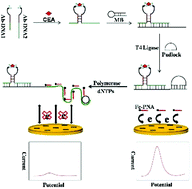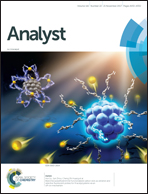Proximity hybridization triggered rolling-circle amplification for sensitive electrochemical homogeneous immunoassay†
Abstract
A new homogeneous electrochemical immunoassay strategy was developed for ultrasensitive detection of carcinoembryonic antigen (CEA) based on target-induced proximity hybridization coupled with rolling circle amplification (RCA). The immobilization-free detection of CEA was realized by the use of an uncharged peptide nucleic acid (PNA) probe labeled with ferrocene (Fc) as the electroactive indicator on a negatively charged indium tin oxide (ITO) electrode. In the presence of a target protein and two DNA-labeled antibodies, the proximate complex formed in homogeneous solution could unfold the molecular beacon, and a part of the unfolded molecular beacon as a primer hybridized with the RCA template to initiate the RCA process. Subsequently, the detection probe modified Fc (Fc-PNAs) hybridized with the long amplified DNA products. The consumption of freely diffusible Fc-PNAs (neutrally charged) resulted in a significant reduction of the Fc signal due to the fact that long amplified DNA/Fc-PNA products were electrostatically repelled from the ITO electrode surface. The reduction of the electrochemical signal (signal-off) could indirectly provide the CEA concentration. Under the optimal conditions, CEA detection was implemented in a wide range from 1 pg mL−1 to 10 ng mL−1, with a low detection limit of 0.49 pg mL−1. The proposed strategy exhibited advantages of good selectivity, high sensitivity, acceptable accuracy, and favorable versatility of analytes. Moreover, the practical application value of the system was confirmed by the assay of CEA in human serums with satisfactory results.



 Please wait while we load your content...
Please wait while we load your content...